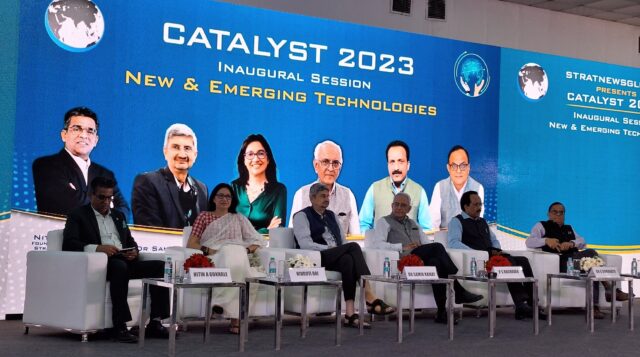NEW DELHI: At the annual India Defence Conclave organised by Bharat Shakti, the point was made that India, one of the fastest-growing markets in the world for digital technologies, has not equipped itself adequately to deal with the growing number of cyber-attacks that have implications for economic and national security. The annual MIT CyberDefense Index report, which looks at 20 of the world’s major economies according to their collective cybersecurity assets, and their ability to deal with cyber-attacks, ranked India 17 out of 20 this year.
The report concluded that “India struggles, despite a digitally forward government and the world’s largest IT-enabled service sectors. This powerful tech force lacks critical infrastructure, has poor national digital economy adoption, and weak cybersecurity regulation.”
Dealing with cyber challenges
While India is making strides to deal with the problem, those within the industry concede that the country will have to up its game if is to deal with the challenge. During a panel discussion, Lt Gen MU Nair, National Cyber Security Coordinator, stated that the problem could only be tackled by the coming together of the private sector, concerned ministries and the military.
“The chairperson of ISRO has already stated that the organisation faces up to 100 cyber-attacks on a daily basis. I would like to widen this discourse to the financial sector. Figures from the NPCI showed that India conducted 10 billion digital transactions between the months of August and September involving 15.75 lakh crore of rupees,” said Nair.
He added that the number of cyber-attacks had risen alarmingly in the self-same period. “The NPCI also states that India has been cyber-attacked 268 times per week in the last six months. This is over six times the global average of 1,165. We are especially vulnerable as our digital infrastructure reaches remote areas of the country.”
Ending technology apathy
While Lt Gen Nair advocated “civil-military fusion” to help deal with the growing problem, the challenges ahead will require some tough decisions to be made. PS Raghavan, chairman of the NSAB, outlined three objectives for the nation which was to strengthen the “indigenous capacity of India’s defence industry, diversify our technology acquisition and technology absorption process and accelerate civil-military fusion.” These objectives however required not just the coming together of relevant stakeholders but a sharp change in mindsets.
Pointing to the Ukraine war as a key example of how cyber and space technologies had enabled pinpoint targeting and greater destruction, Ambassador Raghavan stated that as the world’s largest arms importer India needed to leverage this to enable technology transfers from outside. At the same time, he called for capacity building in the software sector, an area where he believed that India was vulnerable.
“Today we have seen that even non-governmental organisations have access to destructive technologies. Yet, India is woefully short of cyber professionals with domain expertise in various sectors to counter this. We have an urgent need for accreditation programmes to counter this,” he said.
Raghavan added that there also needed to be an end to what he called “technology apathy” amongst officials. “There is inadequate technology literacy which is slowing down its absorption in the civil and defence sector.”
Centres of excellence
Officials pointed out that the government is doing its bit to take on this challenge. Dr Samir Kamat, secretary of the DRDO, stated that the organisation’s aim was to develop critical and cutting-edge technologies for the benefit of the nation.
“DRDO’s focus is on the development of new and emerging critical futuristic technologies for which we will leverage the expertise of MSME, academia and start-ups to ensure the security of the nation,” said Kamat who added that a number of initiatives were being carried out to help promote this.
“Our first initiative is to open 125 centres of excellence. They will act as hubs to create an ecosystem which will make the country a leader in cutting-edge technologies,” said Kamat who added that a Technology Development Fund (TDF) had been set up to fund up to Rs 50 crore, for an idea of an MSME or startup, which showed promise.
Overcoming India’s space challenges
New ideas will be especially welcome in India’s burgeoning space sector. While people from the industry have praised the government’s recently released space policy which lays down clearly defined roles and responsibilities for the DRDO, ISRO and non-governmental assets, they do point out that technology must step in to tackle key challenges in India’s space programme.
Speaking at the conclave, Dr S Somanath, chairman of ISRO, outlined three key challenges for Indian space that he hoped the private sector would help tackle. “The role played by the space sector is going to become more and more prominent in the strategic domain. We need to have low-earth orbit strategic capability, but the main problem is the lack of satellites. We have fewer than 20 satellites in low-earth observation, a number we need to increase quickly.”
“We also need technology growth to enable higher repetitivity, reusability and signal spectral diversity to allow observations of various kinds. Then the Position, Navigation and Timing (PNT) services which are generated by the NavIC system need to be expanded for the purpose of strategic needs. We have to improve the penetration of NavIC into the systems we have in India both in terms of the ground-based system as well as handheld devices. Finally, we need to reduce the launch and launch costs of a satellite. Industry must be incentivised and enabled to produce rockets in large numbers, especially with regard to reusable rockets.”
















